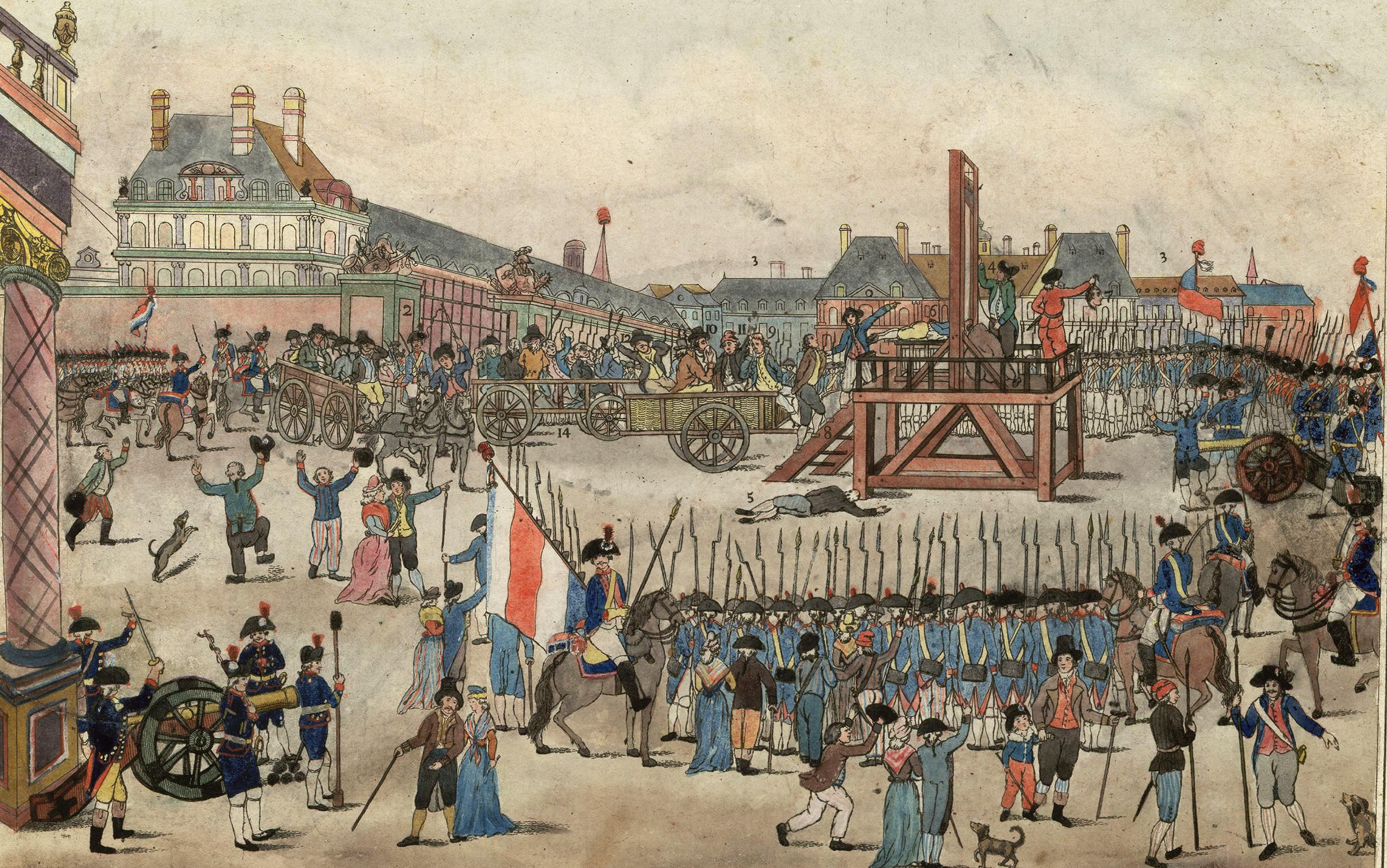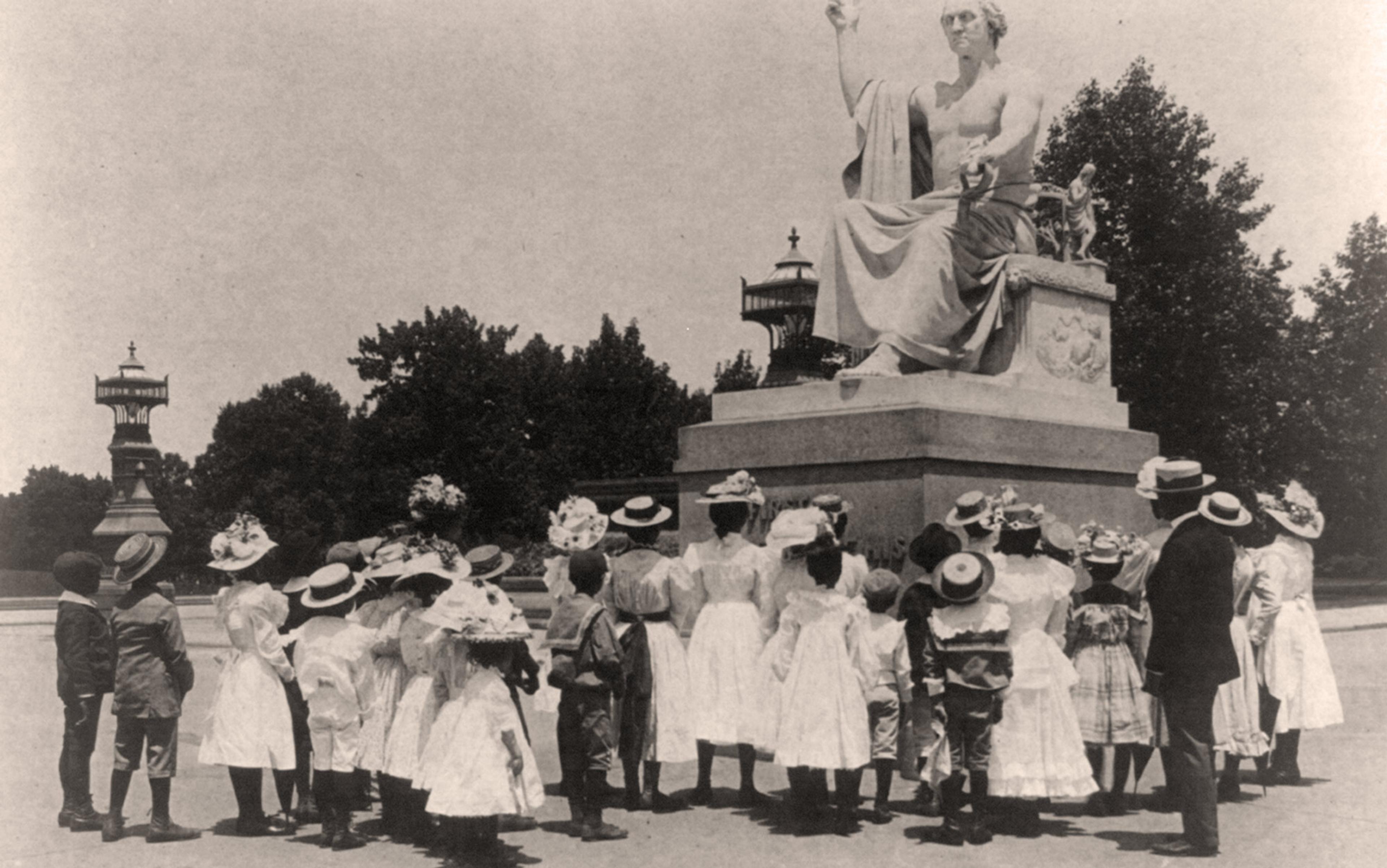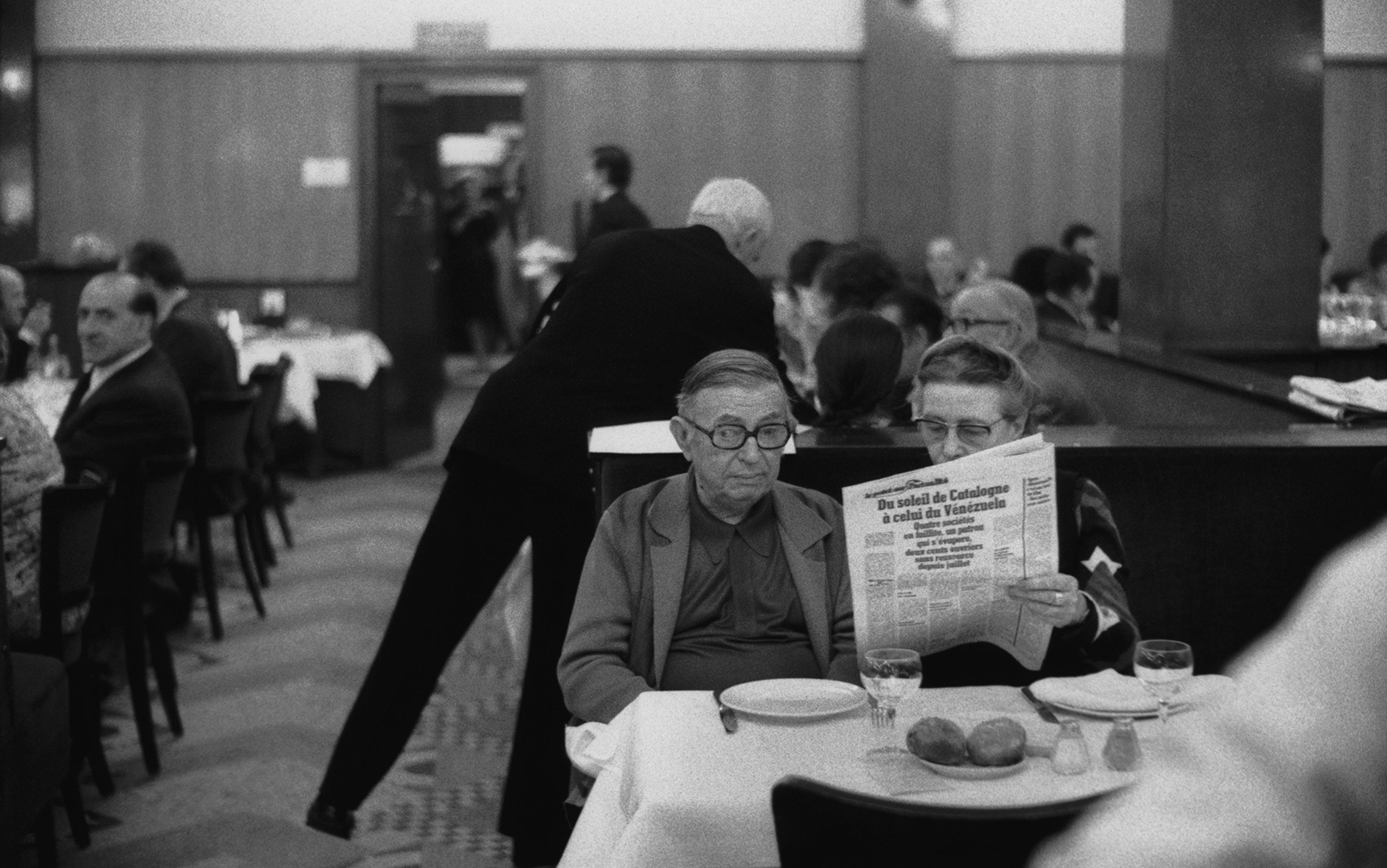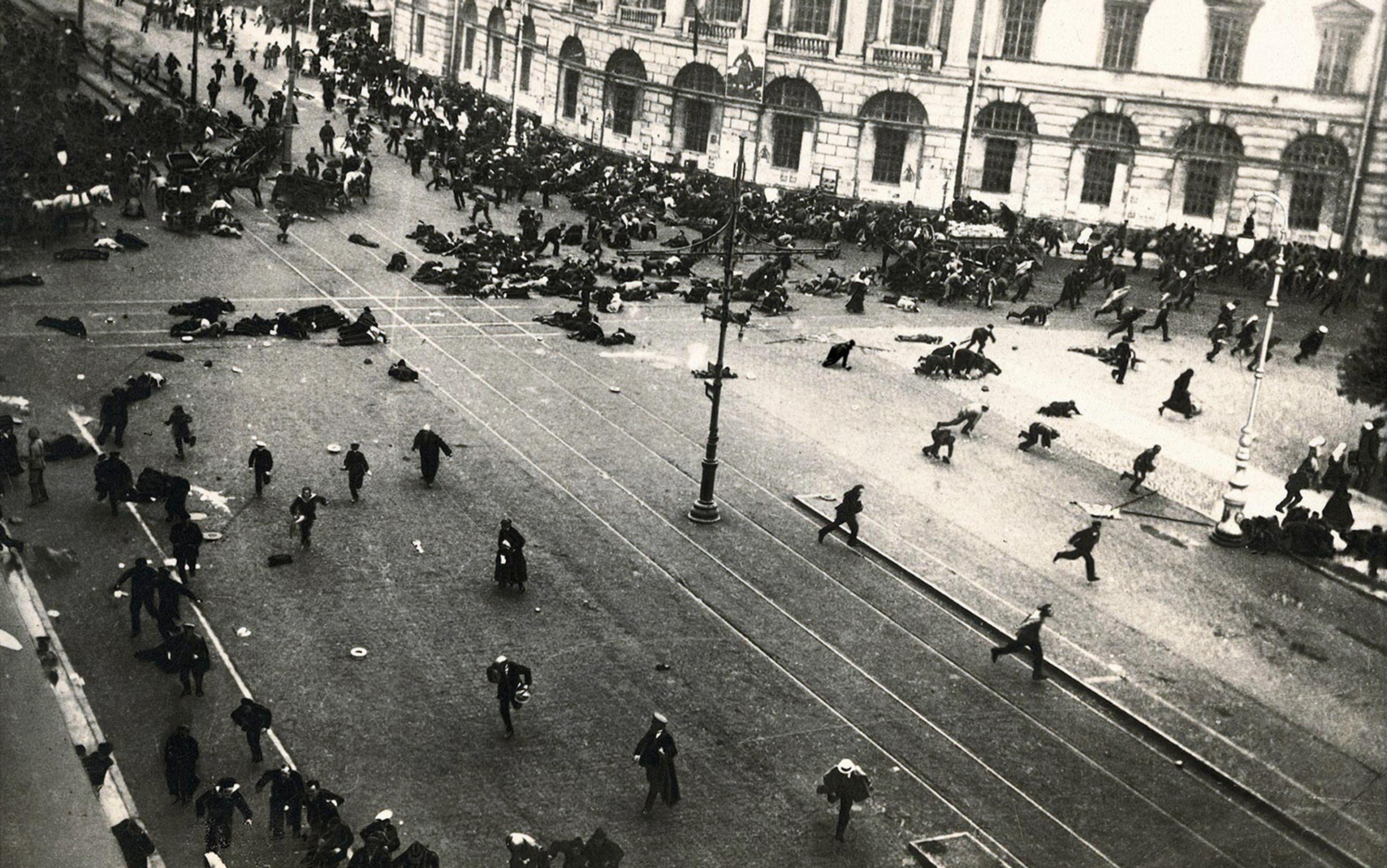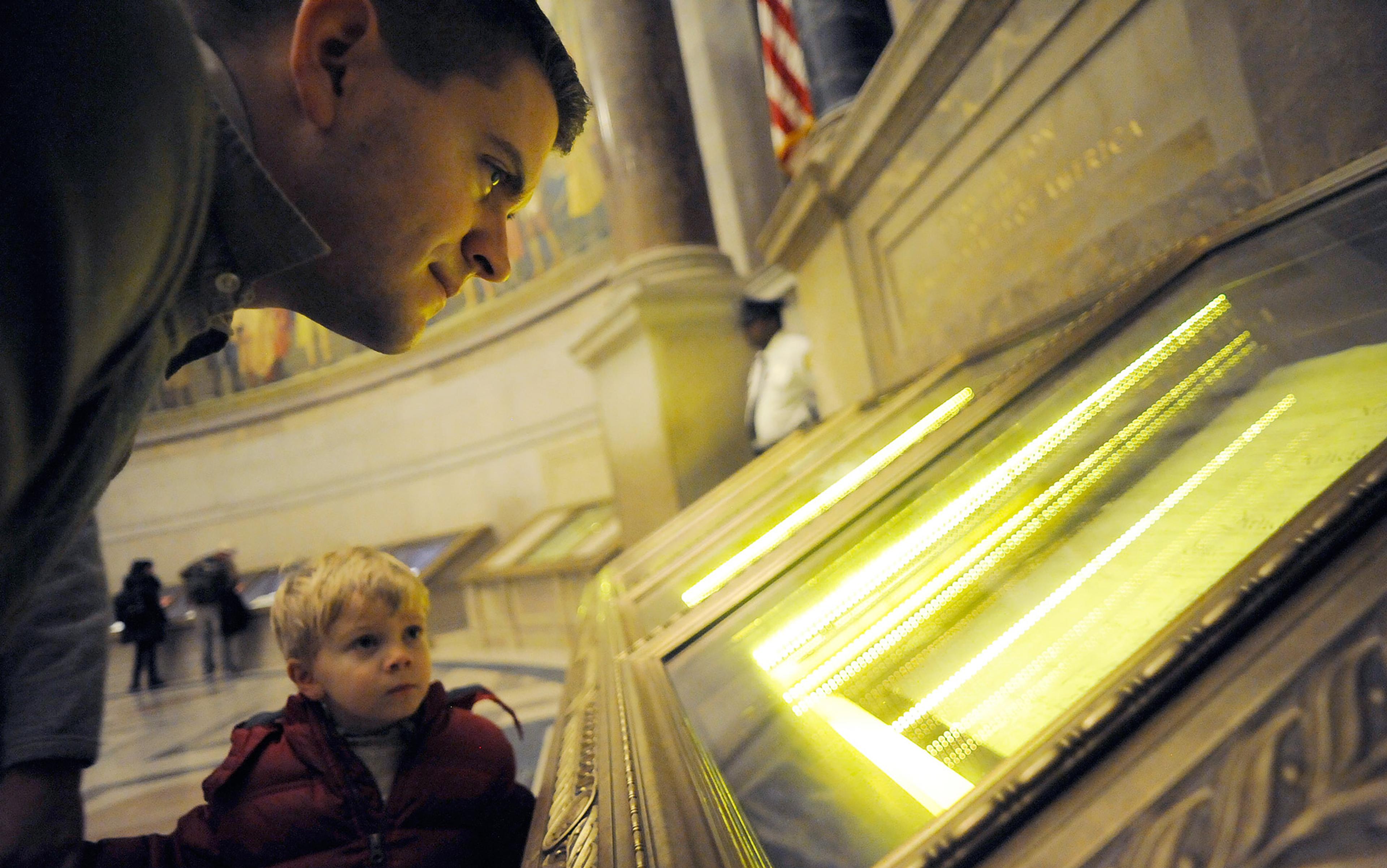If the French Revolution of 1789 was such an important event, visitors to France’s capital city of Paris often wonder, why can’t they find any trace of the Bastille, the medieval fortress whose storming on 14 July 1789 was the revolution’s most dramatic moment? Determined to destroy what they saw as a symbol of tyranny, the ‘victors of the Bastille’ immediately began demolishing the structure. Even the column in the middle of the busy Place de la Bastille isn’t connected to 1789: it commemorates those who died in another uprising a generation later, the ‘July Revolution’ of 1830.
The legacy of the French Revolution is not found in physical monuments, but in the ideals of liberty, equality and justice that still inspire modern democracies. More ambitious than the American revolutionaries of 1776, the French in 1789 were not just fighting for their own national independence: they wanted to establish principles that would lay the basis for freedom for human beings everywhere. The United States Declaration of Independence briefly mentioned rights to ‘liberty, equality, and the pursuit of happiness’, without explaining what they meant or how they were to be realised. The French ‘Declaration of the Rights of Man and Citizen’ spelled out the rights that comprised liberty and equality and outlined a system of participatory government that would empower citizens to protect their own rights.
Much more openly than the Americans, the French revolutionaries recognised that the principles of liberty and equality they had articulated posed fundamental questions about such issues as the status of women and the justification of slavery. In France, unlike the US, these questions were debated heatedly and openly. Initially, the revolutionaries decided that ‘nature’ denied women political rights and that ‘imperious necessity’ dictated the maintenance of slavery in France’s overseas colonies, whose 800,000 enslaved labourers outnumbered the 670,000 in the 13 American states in 1789.
As the revolution proceeded, however, its legislators took more radical steps. A law redefining marriage and legalising divorce in 1792 granted women equal rights to sue for separation and child custody; by that time, women had formed their own political clubs, some were openly serving in the French army, and Olympe de Gouges’s eloquent ‘Declaration of the Rights of Woman’ had insisted that they should be allowed to vote and hold office. Women achieved so much influence in the streets of revolutionary Paris that they drove male legislators to try to outlaw their activities. At almost the same time, in 1794, faced with a massive uprising among the enslaved blacks in France’s most valuable Caribbean colony, Saint-Domingue, the French National Convention abolished slavery and made its former victims full citizens. Black men were seated as deputies to the French legislature and, by 1796, the black general Toussaint Louverture was the official commander-in-chief of French forces in Saint-Domingue, which would become the independent nation of Haiti in 1804.
The French Revolution’s initiatives concerning women’s rights and slavery are just two examples of how the French revolutionaries experimented with radical new ideas about the meaning of liberty and equality that are still relevant. But the French Revolution is not just important today because it took such radical steps to broaden the definitions of liberty and equality. The movement that began in 1789 also showed the dangers inherent in trying to remake an entire society overnight. The French revolutionaries were the first to grant the right to vote to all adult men, but they were also the first to grapple with democracy’s shadow side, demagogic populism, and with the effects of an explosion of ‘new media’ that transformed political communication. The revolution saw the first full-scale attempt to impose secular ideas in the face of vocal opposition from citizens who proclaimed themselves defenders of religion. In 1792, revolutionary France became the first democracy to launch a war to spread its values. A major consequence of that war was the creation of the first modern totalitarian dictatorship, the rule of the Committee of Public Safety during the Reign of Terror. Five years after the end of the Terror, Napoleon Bonaparte, who had gained fame as a result of the war, led the first modern coup d’état, justifying it, like so many strongmen since, by claiming that only an authoritarian regime could guarantee social order.
The fact that Napoleon reversed the revolutionaries’ expansion of women’s rights and reintroduced slavery in the French colonies reminds us that he, like so many of his imitators in the past two centuries, defined ‘social order’ as a rejection of any expansive definition of liberty and equality. Napoleon also abolished meaningful elections, ended freedom of the press, and restored the public status of the Catholic Church. Determined to keep and even expand the revolutionaries’ foreign conquests, he continued the war that they had begun, but French armies now fought to create an empire, dropping any pretence of bringing freedom to other peoples.
The relevance of the French Revolution to present-day debates is the reason why I decided to write A New World Begins: The History of the French Revolution (2020), the first comprehensive English-language account of that event for general readers in more than 30 years. Having spent my career researching and teaching the history of the French Revolution, however, I know very well that it was more than an idealistic crusade for human rights. If the fall of the Bastille remains an indelible symbol of aspirations for freedom, the other universally recognised symbol of the French Revolution, the guillotine, reminds us that the movement was also marked by violence. The American Founding Fathers whose refusal to consider granting rights to women or ending slavery we now rightly question did have the good sense not to let their differences turn into murderous feuds; none of them had to reflect, as the French legislator Pierre Vergniaud did on the eve of his execution, that their movement, ‘like Saturn, is devouring its own children’.
It is hard to avoid concluding that there was a relationship between the radicalism of the ideas that surfaced during the French Revolution and the violence that marked the movement. In my book, I introduce readers to a character, the ‘Père Duchêne’, who came to represent the populist impulses of the revolution. Nowadays, we would call the Père Duchêne a meme. He was not a real person: instead, he was a character familiar to audiences in Paris’s popular theatres, where he functioned as a representative of the country’s ordinary people. Once the revolution began, a number of journalists began publishing pamphlets supposedly written by the Père Duchêne, in which they demanded that the National Assembly do more to benefit the poor. The small newspapers that used his name carried a crude woodcut on their front page showing the Père Duchêne in rough workers’ clothing. Holding a hatchet over his head, with two pistols stuck in his belt and a musket at his side, the Père Duchêne was a visual symbol of the association between the revolution and popular violence.
The elites had enriched themselves at the expense of the people, and needed to be forced to share their power
Although his crude language and his constant threat to resort to violence alienated the more moderate revolutionaries, the Père Duchêne was the living embodiment of one of the basic principles incorporated in the Declaration of the Rights of Man and Citizen. The sixth article of that document affirmed that ‘the law is the expression of the general will’ and promised that ‘all citizens have the right to participate personally, or through their representatives, in its establishment’. The fictitious Père Duchêne’s message to readers, no matter how poor and uneducated they might be, was that an ordinary person could claim a voice in politics.
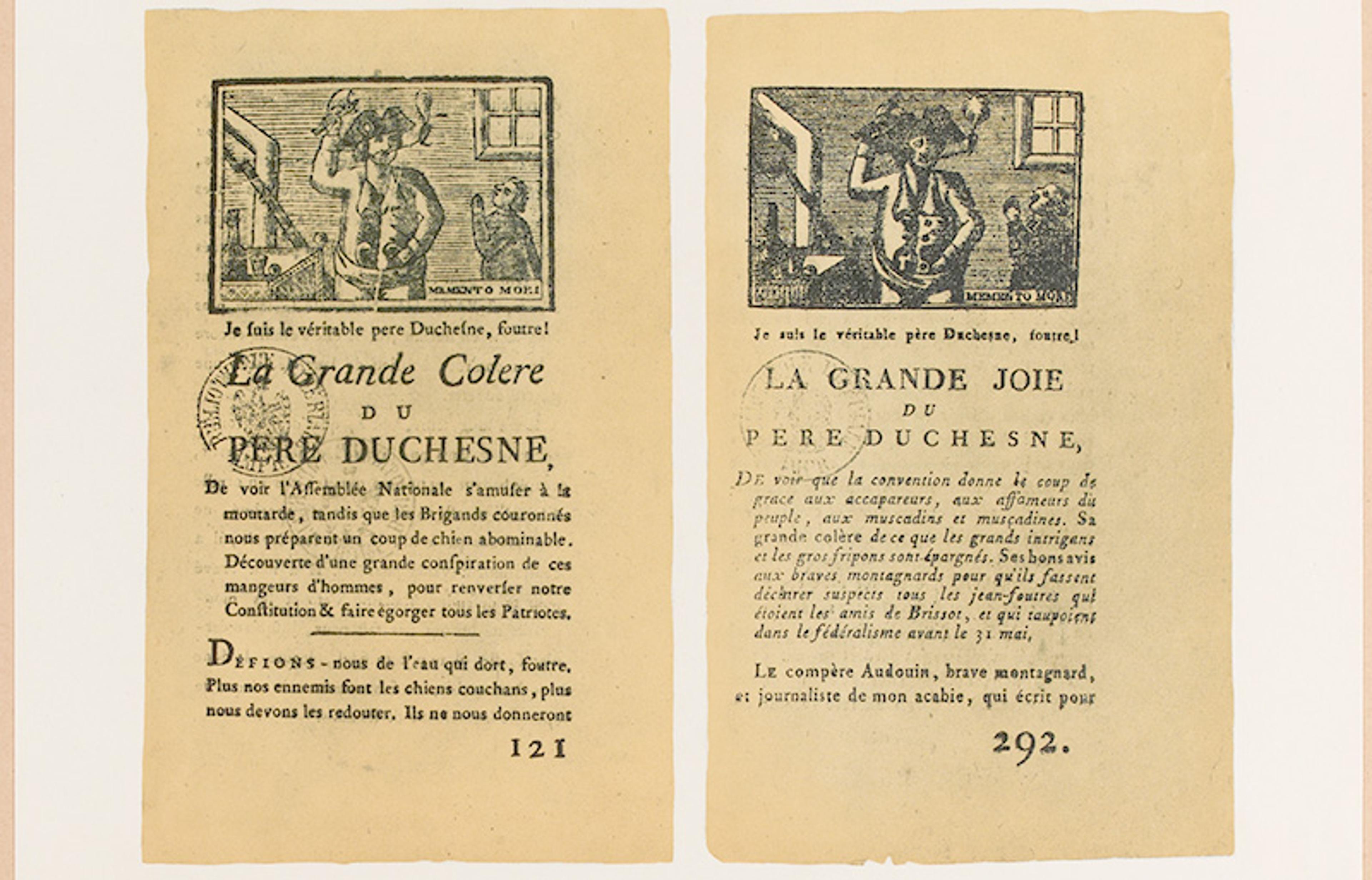
The Great Anger and The Great Joy of Père Duchêne, Hébert’s radical and rabble-rousing pamphlet. Courtesy Musée Carnavalet, Paris
Like present-day populists, the Père Duchêne had a simple political programme. The elites who ruled France before 1789 had enriched themselves at the expense of the people. They needed to be forced to share their power and wealth. When the revolution did not immediately improve the lives of the masses, the Père Duchêne blamed the movement’s more moderate leaders, accusing them of exploiting it for their own benefit. The journalists who wrote under the name of the Père Duchêne used colourful language laced with obscenities; they insisted that their vulgarity showed that they were ‘telling it like it is’. Their tone was vindictive and vengeful; they wanted to see their targets humiliated and, in many cases, sent to the guillotine. The most successful Père Duchêne journalist, Jacques-René Hébert, built a political career through his success in using the media. At the height of the Reign of Terror, he pushed through the creation of a ‘revolutionary army’ controlled by his friends to intimidate enemies of the revolution, and seemed on the verge of taking over the government.
Maximilien Robespierre and his more middle-class colleagues on the Committee of Public Safety feared that Hébert’s populist movement might drive them from power. They decided that they had no choice but to confront Hébert and his followers, even if it meant alienating the ‘base’ of ordinary Paris residents, the famous sans-culottes. Using the same smear tactics that the Père Duchêne had perfected, they accused Hébert of dubious intrigues with foreigners and other questionable activities. Like many bullies, Hébert quickly collapsed when he found himself up against serious opponents determined to fight back; the crowd that cheered his dispatch to the guillotine in March 1794 was larger than for many of the executions that he had incited. But he and the other Père Duchênes, as well as their female counterparts, the Mère Duchênes who flourished at some points in the revolution, had done much to turn the movement from a high-minded crusade for human rights into a free-for-all in which only the loudest voices could make themselves heard.
The ambivalent legacy of the French Revolution’s democratic impulse, so vividly brought to life in the figure of the Père Duchêne, underlines the way in which the movement begun in 1789 remains both an inspiration and a warning for us today. In the more than 200 years since the storming of the Bastille, no one has formulated the human yearning for freedom and justice more eloquently than the French revolutionaries, and no one has shown more clearly the dangers that a one-sided pursuit of those goals can create. The career of the most famous of the radical French revolutionaries, Robespierre, is the most striking demonstration of that fact.
Robespierre is remembered because he was the most eloquent defender of the dictatorship created during the revolution’s most radical period, the months known as the Reign of Terror. Robespierre’s speech on the principles of revolutionary government, delivered on 25 December 1793, made an uncompromising case for the legitimacy of extreme measures to defeat those he called ‘the enemies of liberty’. Paradoxically, he insisted, the only way to create a society in which citizens could exercise the individual freedoms promised in the Declaration of Rights was to suspend those rights until the revolution’s opponents were conclusively defeated.
Robespierre’s colleagues on the all-powerful Committee of Public Safety chose him to defend their policies because he was more than just a spokesman for harsh measures against their opponents. From the time he first appeared on the scene as one of the 1,200 deputies to the Estates General summoned by Louis XVI in May 1789, his fellow legislators recognised the young provincial lawyer’s intelligence and his unswerving commitment to the ideals of democracy. The renegade aristocrat the comte de Mirabeau, the most prominent spokesman of the revolutionary ‘patriots’ in 1789 but an often cynical pragmatist, quickly sized up his colleague: ‘That man will go far, because he believes everything he says.’ Unlike the Père Duchêne, Robespierre always dressed carefully and spoke in pure, educated French. Other revolutionary leaders, like the rabblerousing orator Georges Danton, were happy to join insurrectionary crowds in the streets; Robespierre never personally took part in any of the French Revolution’s explosions of violence. Yet no one remains more associated with the violence of the Reign of Terror than Robespierre.
To reduce Robespierre’s legacy to his association with the Terror is to overlook the importance of his role as a one of history’s most articulate proponents of political democracy. When the majority of the deputies in France’s revolutionary National Assembly tried to restrict full political rights to the wealthier male members of the population, Robespierre reminded them of the Declaration of Rights’ assertion that freedom meant the right to have a voice in making the laws that citizens had to obey. ‘Is the law the expression of the general will, when the greater number of those for whom it is made cannot contribute to its formation?’ he asked. Long before our present-day debates about income inequality, he denounced a system that put real political power in the hands of the wealthy: ‘And what an aristocracy! The most unbearable of all, that of the rich.’ In the early years of the revolution, Robespierre firmly defended freedom of the press and called for the abolition of the death penalty. When white colonists insisted that France could not survive economically without slavery, Robespierre cried out: ‘Perish the colonies rather than abandon a principle!’
The majority of the population was not ready to embrace a radical secularist movement
Explaining how Robespierre, the principled defender of liberty and equality, became in just a few short years the leading advocate of a system of revolutionary government that foreshadowed the 20th century’s totalitarian dictatorships is perhaps the greatest challenge in defending the legacy of the French Revolution. Robespierre was no innocent, and in the last months of his short political career – he was only 36 when he died – his clumsy confrontations with his colleagues made him a dangerous number of enemies. Unlike the Père Duchêne, however, Robespierre never embraced violence as an end in itself, and a close examination of his career shows that he was often trying to find ways to limit the damage caused by policies he had not originally endorsed. In 1792, when most of his fellow Jacobin radicals embraced the call for a revolutionary war to ensure France’s security by toppling the hostile monarchies surrounding it, Robespierre warned against the illusion that other peoples would turn against their own governments to support the French. ‘No one loves armed missionaries,’ he insisted, a warning that recent US leaders might have done well to heed.
When radicals such as Hébert started a campaign to ‘de-Christianise’ France, in order to silence opposition to the movement’s effort to reform the Catholic Church and sell off its property for the benefit of the revolution, Robespierre reined them in. He recognised that the majority of the population was not ready to embrace a radical secularist movement bent on turning churches into ‘temples of reason’ and putting up signs in cemeteries calling death ‘an eternal sleep’. Robespierre proposed instead the introduction of a purified and simplified ‘cult of the Supreme Being’, which he thought believers could embrace without abandoning their faith in a higher power and their belief in the immortality of the soul.
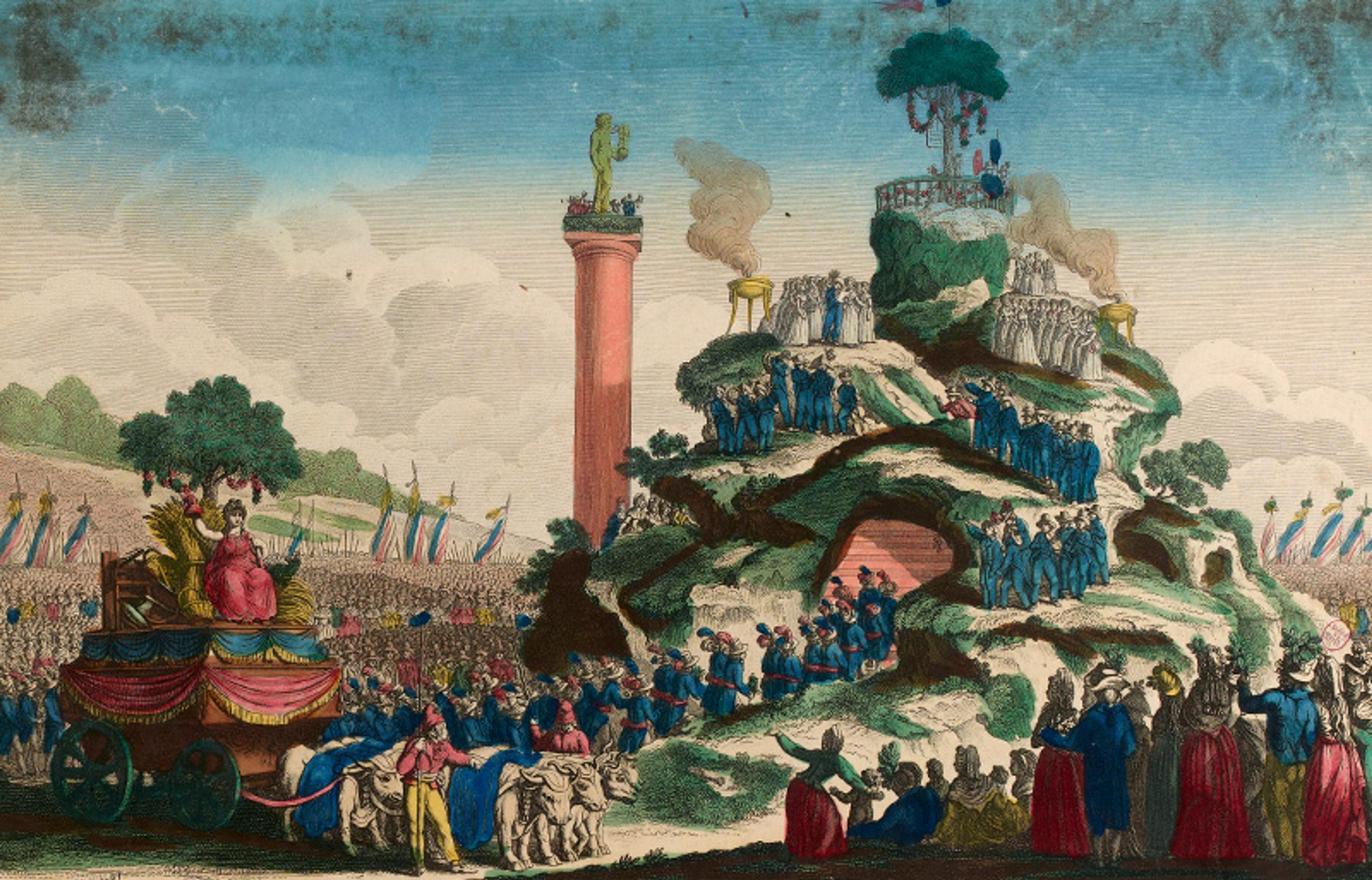
To inaugurate the new state religion, Robespierre declared 8 June 1794 (20 Prairial Year II) to be the Festival of the Supreme Being. The festival was organised by the artist Jacques-Louis David and took place around a man-made mountain on the Champ de Mars. Courtesy Musée Carnavalet, Paris
Robespierre knew that many of the revolution’s bitterest opponents were motivated by loyalty to the Catholic Church. The revolution had not begun as an anti-religious movement. Under the rules used in the elections to what became the French National Assembly in 1789, a fourth of all the deputies were clergy from the Catholic Church, an institution so woven into the fabric of the population’s life that hardly anyone could imagine its disappearance. Criticism that the Church had grown too wealthy and that many of its beliefs failed to measure up to the standards of reason promoted by the Enlightenment was widespread, even among priests, but most hoped to see religion, like every other aspect of French life, ‘regenerated’ by the impulses of the revolution, not destroyed.
The revolutionaries’ confrontation with the Church began, not with an argument about beliefs, but because of the urgent need to meet the crisis in government revenues that had forced king Louis XVI to summon a national assembly in the first place. Determined to avoid a chaotic public bankruptcy, and reluctant to raise taxes on the population, the legislators decided, four months after the storming of the Bastille, to put the vast property of the Catholic Church ‘at the disposition of the nation’. Many Catholic clergy, especially underpaid parish priests who resented the luxury in which their aristocratic bishops lived, supported the expropriation of Church property and the idea that the government, which now took over the responsibility for funding the institution, had the right to reform it. Others, however, saw the reform of the Church as a cover for an Enlightenment-inspired campaign against their faith, and much of the lay population supported them. In one region of France, peasants formed a ‘Catholic and Royal Army’ and revolted against the revolution that had supposedly been carried out for their benefit. Women, who found in the cult of Mary and female saints a source of psychological support, were often in the forefront of this religiously inspired resistance to the revolution.
To supporters of the revolution, this religious opposition to their movement looked like a nationwide conspiracy preventing progress. The increasingly harsh measures taken to quell resistance to Church reform prefigured the policies of the Reign of Terror. The plunge into war in the spring of 1792, justified in part to show domestic opponents of the revolution that they could not hope for any support from abroad, allowed the revolutionaries to define the disruptions caused by diehard Catholics as forms of treason. Suspicions that Louis XVI, who had accepted the demand for a declaration of war, and his wife Marie-Antoinette were secretly hoping for a quick French defeat that would allow foreign armies to restore their powers led to their imprisonment and execution.
Accusations of foreign meddling in revolutionary politics, a so-called foreign plot that supposedly involved the payment of large sums of money to leading deputies to promote special interests and undermine French democracy, were another source of the fears that fuelled the Reign of Terror. Awash in a sea of ‘fake news’, political leaders and ordinary citizens lost any sense of perspective, and became increasingly ready to believe even the most far-fetched accusations. Robespierre, whose personal honesty had earned him the nickname ‘The Incorruptible’, was particularly quick to suspect any of his colleagues who seemed ready to tolerate those who enriched themselves from the revolution or had contacts with foreigners. Rather than any lust for power, it was Robespierre’s weakness for seeing any disagreement with him as a sign of corruption that led him to support the elimination of numerous other revolutionary leaders, including figures, such as Danton, who had once been his close allies. Other, more cynical politicians joined Robespierre in expanding the Reign of Terror, calculating that their own best chance of survival was to strike down their rivals before they themselves could be targeted.
Although the toxic politics of its most radical phase did much to discredit the revolution, the ‘Reign of Terror’, which lasted little more than one year out of 10 between the storming of the Bastille and Napoleon’s coup d’état, was also a time of important experiments in democracy. While thousands of ordinary French men and women found themselves unjustly imprisoned during the Terror, thousands of others – admittedly, only men – held public office for the first time. The same revolutionary legislature that backed Robespierre and the Committee of Public Safety took the first steps toward creating a modern national welfare system and passed plans for a comprehensive system of public education. Revolutionary France became the first country to create a system of universal military conscription and to promise ordinary soldiers that, if they proved themselves on the battlefield, there was no rank to which they could not aspire. The idea that society needed a privileged leadership class in order to function was challenged as never before.
Among the men from modest backgrounds who rose to positions they could never have attained before 1789 was a young artillery officer whose strong Corsican accent marked him as a provincial: Napoleon. A mere lieutenant when the Bastille was stormed, he was promoted to general just four years later, after impressing Robespierre’s brother Augustin with his skill in defeating a British invasion force on France’s southern coast. Five years after the overthrow of Robespierre on 27 July 1794 – or 9 Thermidor Year II, according to the new calendar that the revolutionaries had adopted to underline their total break with the past – Napoleon joined with a number of revolutionary politicians to overthrow the republican regime that had come out of the revolution and replace it with what soon became a system of one-man rule. Napoleon’s seizure of power has been cited ever since as evidence that the French Revolution, unlike the American, was essentially a failure. The French revolutionaries, it is often said, had tried to make too many changes too quickly, and the movement’s violence had alienated too much of the population to allow it to succeed.
To accept this verdict on the French Revolution is to ignore a crucial but little-known aspect of its legacy: the way in which the movement’s own leaders, determined to escape from the destructive politics of the Reign of Terror after Robespierre’s death, worked to ‘exit from the Terror’, as one historian has put it, and create a stable form of constitutional government. The years that history books call the period of the ‘Thermidorian reaction’ and the period of the Directory, from July 1794 to November 1799, comprise half of the decade of the French Revolution. They provide an instructive lesson in how a society can try to put itself back on an even keel after an experience during which all the ordinary rules of politics have been broken.
The post-Robespierre republic was brought down by the disloyalty of its own political elite
One simple lesson from the post-Terror years of the revolution that many subsequent politicians have learned is to blame all mistakes on one person. In death, Robespierre was built up into a ‘tiger thirsty for blood’ who had supposedly wanted to make himself a dictator or even king. All too aware that, in reality, thousands of others had helped to make the revolutionary government function, however, Robespierre’s successors found themselves under pressure to bring at least some of the Terror’s other leaders to justice. At times, the process escaped from control, as when angry crowds massacred political prisoners in cities in the south during a ‘white terror’ in 1795. On the whole, however, the republican leaders after 1794 succeeded in convincing the population that the excesses of the Terror would not be repeated, even if some of the men in power had been as deeply implicated in those excesses as Robespierre.
For five years after Robespierre’s execution, France lived under a quasi-constitutional system, in which laws were debated by a bicameral legislature and discussed in a relatively free press. On several occasions, it is true, the Directory, the five-man governing council, ‘corrected’ the election results to ensure its own hold on power, undermining the authority of the constitution, but the mass arrests and arbitrary trials that had marked the Reign of Terror were not repeated. The Directory’s policies enabled the country’s economy to recover after the disorder of the revolutionary years. Harsh toward the poor who had identified themselves with the Père Duchêne, it consolidated the educational reforms started during the Terror. Napoleon would build on the Directory’s success in establishing a modern, centralised system of administration. He himself was one of the many military leaders who enabled France to defeat its continental enemies and force them to recognise its territorial gains.
Although legislative debates in this period reflected a swing against the expanded rights granted to women earlier in the revolution, the laws passed earlier were not repealed. Despite a heated campaign waged by displaced plantation-owners, the thermidorians and the Directory maintained the rights granted to the freed blacks in the French colonies. Black men from Saint-Domingue and Guadeloupe were elected as deputies and took part in parliamentary debates. In Saint-Domingue, the black general Louverture commanded French forces that defeated a British invasion; by 1798, he had been named the governor of the colony. His power was so great that the American government, by this time locked in a ‘quasi-war’ with France, negotiated directly with him, hoping to bring pressure on Paris to end the harassment of American merchant ships in the Caribbean.
The post-Robespierre French republic was brought down, more than anything else, by the disloyalty of its own political elite. Even before Napoleon unexpectedly returned from the expedition to Egypt on which he had been dispatched in mid-1798, many of the regime’s key figures had decided that the constitution they themselves had helped to draft after Robespierre’s fall provided too many opportunities for rivals to challenge them. What Napoleon found in the fall of 1799 was not a country on the verge of chaos but a crowd of politicians competing with each other to plan coups to make their positions permanent. He was able to choose the allies who struck him as most likely to serve his purposes, knowing that none of them had the popularity or the charisma to hold their own against him once the Directory had been overthrown.
One cannot simply conclude, then, that the history of the French Revolution proves that radical attempts to change society are doomed to failure, or that Napoleon’s dictatorship was the inevitable destination at which the revolution was doomed to arrive. But neither can one simply hail the French movement as a forerunner of modern ideas about liberty and equality. In their pursuit of those goals, the French revolutionaries discovered how vehemently some people – not just privileged elites but also many ordinary men and women – could resist those ideas, and how dangerous the impatience of their own supporters could become. Robespierre’s justification of dictatorial methods to overcome the resistance to the revolution had a certain logic behind it, but it opened the door to many abuses.
Despite all its violence and contradictions, however, the French Revolution remains meaningful for us today. To ignore or reject the legacy of its calls for liberty and equality amounts to legitimising authoritarian ideologies or arguments for the inherent inequality of certain groups of people. If we want to live in a world characterised by respect for fundamental individual rights, we need to learn the lessons, both positive and negative, of the great effort to promote those ideals that tore down the Bastille in 1789.
